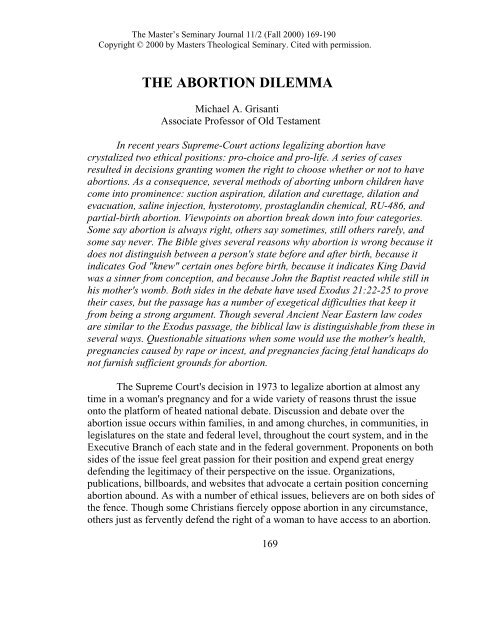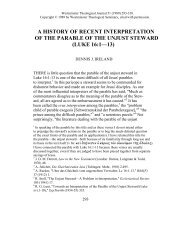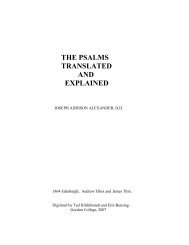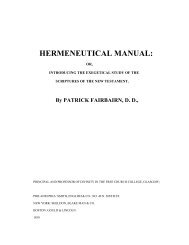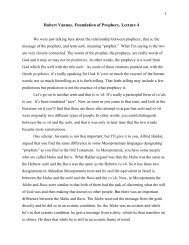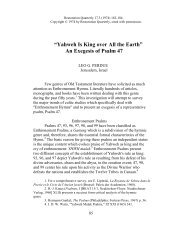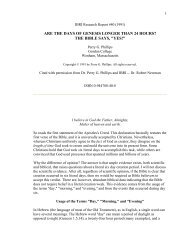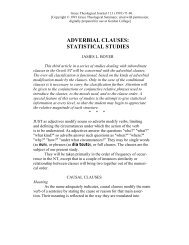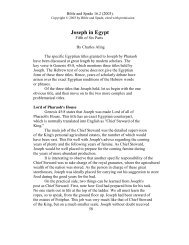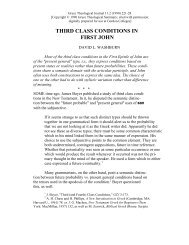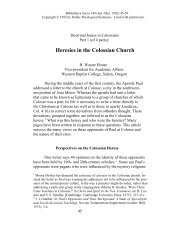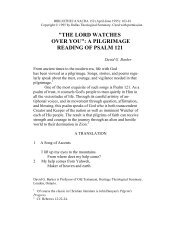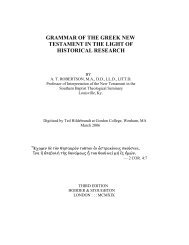The Abortion Dilemma - Gordon College Faculty
The Abortion Dilemma - Gordon College Faculty
The Abortion Dilemma - Gordon College Faculty
Create successful ePaper yourself
Turn your PDF publications into a flip-book with our unique Google optimized e-Paper software.
<strong>The</strong> Master’s Seminary Journal 11/2 (Fall 2000) 169-190<br />
Copyright © 2000 by Masters <strong>The</strong>ological Seminary. Cited with permission.<br />
THE ABORTION DILEMMA<br />
Michael A. Grisanti<br />
Associate Professor of Old Testament<br />
In recent years Supreme-Court actions legalizing abortion have<br />
crystalized two ethical positions: pro-choice and pro-life. A series of cases<br />
resulted in decisions granting women the right to choose whether or not to have<br />
abortions. As a consequence, several methods of aborting unborn children have<br />
come into prominence: suction aspiration, dilation and curettage, dilation and<br />
evacuation, saline injection, hysterotomy, prostaglandin chemical, RU-486, and<br />
partial-birth abortion. Viewpoints on abortion break down into four categories.<br />
Some say abortion is always right, others say sometimes, still others rarely, and<br />
some say never. <strong>The</strong> Bible gives several reasons why abortion is wrong because it<br />
does not distinguish between a person's state before and after birth, because it<br />
indicates God "knew" certain ones before birth, because it indicates King David<br />
was a sinner from conception, and because John the Baptist reacted while still in<br />
his mother's womb. Both sides in the debate have used Exodus 21:22-25 to prove<br />
their cases, but the passage has a number of exegetical difficulties that keep it<br />
from being a strong argument. Though several Ancient Near Eastern law codes<br />
are similar to the Exodus passage, the biblical law is distinguishable from these in<br />
several ways. Questionable situations when some would use the mother's health,<br />
pregnancies caused by rape or incest, and pregnancies facing fetal handicaps do<br />
not furnish sufficient grounds for abortion.<br />
<strong>The</strong> Supreme Court's decision in 1973 to legalize abortion at almost any<br />
time in a woman's pregnancy and for a wide variety of reasons thrust the issue<br />
onto the platform of heated national debate. Discussion and debate over the<br />
abortion issue occurs within families, in and among churches, in communities, in<br />
legislatures on the state and federal level, throughout the court system, and in the<br />
Executive Branch of each state and in the federal government. Proponents on both<br />
sides of the issue feel great passion for their position and expend great energy<br />
defending the legitimacy of their perspective on the issue. Organizations,<br />
publications, billboards, and websites that advocate a certain position concerning<br />
abortion abound. As with a number of ethical issues, believers are on both sides of<br />
the fence. Though some Christians fiercely oppose abortion in any circumstance,<br />
others just as fervently defend the right of a woman to have access to an abortion.<br />
169
170 <strong>The</strong> Master's Seminary Journal<br />
What does the Bible have to say about the practice of abortion? How<br />
should that belief affect Christian conduct in a world given over to paganism? In<br />
other words, how does a believer flesh out his belief about abortion in his life and<br />
ministry?<br />
By definition, an abortion involves the "expulsion of the human fetus ...<br />
before it is capable of surviving outside the womb." 1 <strong>The</strong> two general categories of<br />
abortion are the spontaneous and the induced. A spontaneous abortion is one that<br />
takes place naturally, with no external intervention. It represents a situation over<br />
which the mother has no control. In a number of cases, a fertilized egg never<br />
implants in the mother's womb and passes out of her body during her monthly<br />
period. Another kind of a spontaneous abortion involves a miscarriage. In this<br />
instance, the mother's body expels the developing fetus before the baby is able to<br />
live outside the womb. 2 <strong>The</strong> second category of abortion involves an induced<br />
abortion, i.e., one brought about by medical means (discussed at length below).<br />
Statistically speaking, since the Supreme Court's decision of 1973 (Roe v.<br />
Wade), the annual number of abortions has risen from 744,600 to a peak of 1.6<br />
million (approximately 1.6 million abortions were performed annually from 1980-<br />
1992). After 1992 the number of abortions performed annually slowly dropped to<br />
1.4 million in 1.996. 3 From 1973 through :1996, an estimated 34.4 million unborn<br />
babies have died in hospitals and abortion clinics throughout America. In the past<br />
4 years, abortions terminated between one-quarter and one-third of all pregnancies<br />
in America. Approximately 52% of women obtaining abortions in the U.S. are<br />
younger than 25. 4 Over half of unintended pregnancies worldwide end with<br />
induced abortion. 5 It has become the second most common surgical procedure in<br />
our country, circumcision being the first. 6<br />
<strong>The</strong> basic question in this debate is "Are you in favor of abortion (proabortion)<br />
or opposed to it (anti-abortion)?" Or to put it another way, "Are you prochoice<br />
or pro-life?" <strong>The</strong> foundation for this decision is this: Does a woman have<br />
the right to do whatever she wishes with her body (choice), or is the human<br />
responsibil-<br />
1 Charles C. Ryrie, Biblical Answers to Contemporary Issues (Chicago: Moody, 1991) 85.<br />
2 John S. Feinberg and Paul D. Feinberg, Ethics for a Brave New World (Wheaton, Ill.:<br />
Crossway, 1993) 50.<br />
3 <strong>The</strong>se statistics are available on numerous web sites dealing with the issue of abortion. For<br />
two examples, see the home page for the Alan Guttmacher Institute, a pro-choice research center<br />
(www.agi-usa.org/pubs/fb_induced_abortion.html) and the Ohio Right to Life home page<br />
(www.ohiolife.org/stats/us 1996.htm).<br />
4 Women aged 20-24 obtain 32% of all abortions while teenagers obtain 20% (www.agi-<br />
usa.org/pubs/fb_induced_abortion.html).<br />
5 According to the Alan Guttmacher Institute, this involves 46 million pregnancies (and<br />
abortions) worldwide (www.agi-usa.org/pubs/ib_0599.html).<br />
6 According to J. Kerby Anderson (Moral <strong>Dilemma</strong>s: Biblical Perspectives on Contemporary<br />
Issues [Nashville: Word, 1998] 227 n. 1, drawing on material from the National Center for Health<br />
Statistics, Atlanta, Ga.), abortion is the most frequently performed surgery on adults in America.
<strong>The</strong> <strong>Abortion</strong> <strong>Dilemma</strong> 171<br />
ity to preserve life at all times (life)?<br />
Neither set of proponents finds total agreement with the titles given them.<br />
<strong>The</strong> pro-abortionist does not regard herself/himself as anti-life even though he or<br />
she does not view the fetus as a person. A number of women regard themselves as<br />
pro-choice but not pro-abortion. Nor is the anti-abortionist really anti-choice. A<br />
woman does have the responsibility to take care of her body. However, the issue<br />
of abortion touches two lives, those of the mother and of the unborn child. Those<br />
who oppose abortion contend that the mother's preferences should not have<br />
preeminence over the unborn child's life. Consequently, the debate over abortion<br />
is normally categorized by two basic positions: pro-choice and pro-life. 7<br />
THE LEGAL BACKGROUND OF ABORTION<br />
Various sources document the legal history of the abortion debate. As part<br />
of their discussion of the larger issue, numerous volumes that focused on the issue<br />
of abortion or ethics in general provide a helpful overview of this legal history. 8<br />
More recently, various websites offer the full text of the various legal decisions as<br />
well as links to other related websites. 9 One has only to type the word "abortion"<br />
in one of the major web search engines to find hundreds of places to find information<br />
of this kind.<br />
Roe v. Wade (1973) 10<br />
On January 22, 1973, the Supreme Court ruled that an unborn child is the<br />
property of the mother. It concluded that she might dispose of it for any reason<br />
during the first six months of pregnancy, and at any other time (last trimester) if,<br />
in the opinion of a single licensed physician, it is necessary to preserve her life and<br />
health. During the first three months of pregnancy, abortion may not be regulated.<br />
During the second trimester, it may be regulated only with reference to the<br />
protection of the "mother's" health.<br />
7<br />
<strong>The</strong> complaint of this writer about media coverage of this issue is the frequent use of unequal<br />
terms for the two sides. Those in favor of abortion are said to be pro-choice (not pro-abortion or<br />
anti-life). But those opposed to abortion are referred to as anti-abortion or anti-choice (not prolife).<br />
8 Feinberg and Feinberg, Ethics 48-50; Scott B. Rae, Moral Choices: An Introduction to Ethics<br />
(Grand Rapids: Zondervan, 1995) 118-22; Curt Young, <strong>The</strong> Least of <strong>The</strong>se (Chicago: Moody,<br />
1984) 21-32.<br />
9<br />
<strong>Abortion</strong> Law Homepage (http://members.aol.com/abtrbng/index.htm); cf.<br />
www.abortioninfo.net /facts.<br />
10 410 U.S. 113 (1973).
172 <strong>The</strong> Master's Seminary Journal<br />
Doe v. Bolton (1973) 11<br />
In a companion case decided on the same day as Roe v. Wade, the Supreme<br />
Court struck down a Georgia law that placed several limitations on abortion. Any<br />
attempts to place limits on a woman's right to an abortion had to conform to "a<br />
compelling state interest." It is important to note that the Supreme Court justices<br />
interpreted the mother's health to include her psychological and emotional health<br />
in addition to her physical health.<br />
Planned Parenthood v. Danforth (1977) 12<br />
This case removed some of the limits that had been placed on abortion by<br />
Roe v. Wade (e.g., spousal consent, parental consent for a minor child). <strong>The</strong><br />
woman and her physician were the only ones legally involved in the decisionmaking<br />
process.<br />
Webster v. Reproductive Health Services (1989) 13<br />
This case represented one of the first significant limits on an individual's<br />
right to an abortion. Reversing certain lower court decisions, the Supreme Court<br />
upheld a Missouri law that prohibited the use of public funds or medical facilities<br />
for "non-therapeutic" abortions. Building on the Hyde Amendment that dealt with<br />
the use of federal funds for abortions, this case concerned the right of states to<br />
limit or prohibit the use of tax funds to pay for abortions.<br />
Planned Parenthood v. Casey (1992) 14<br />
Pro-choice proponents brought this case to the Supreme Court to protest<br />
limitations placed on abortion in the state of Pennsylvania (Casey was the<br />
governor of the state). <strong>The</strong> state law in question required that a woman seeking an<br />
abortion give informed consent after receiving certain relevant information 24<br />
hours before the procedure (explanation of procedure, risks of abortion, probable<br />
gestational age of fetus), informed parental consent for a minor child, and<br />
evidence of spousal notification. Pro-life advocates regarded this case as the best<br />
opportunity to overturn Roe v. Wade and pro-choice proponents hoped that the<br />
Supreme Court would strike down all the limitations. Neither side was totally<br />
satisfied with the outcome. <strong>The</strong> Supreme Court did not overturn Roe v. Wade but<br />
retained all the<br />
11 410 U.S. 179 (1973).<br />
12 428 U.S. 52 (1977).<br />
13 109 S. Ct. 3040 (1989).<br />
14 112 S. Ct. 2791 (1992).
<strong>The</strong> <strong>Abortion</strong> <strong>Dilemma</strong> 173<br />
limitations except the spousal notification feature.<br />
Clinton's Withdrawal of Executive Support for the Unborn<br />
Although it does not belong to the legal/court history of the abortion battle,<br />
one should remember President Clinton's contribution to this debate. On January<br />
20, 1993, while the annual protest against Roe v. Wade was going on outside the<br />
White House, President Clinton reversed more than a decade of executive support<br />
for the unborn with one stroke of the pen. 15 He signed an executive order that did<br />
three things:<br />
He lifted the "gag rule" that had prohibited workers in federally funded<br />
health clinics from mentioning abortion as an alternative to dealing<br />
with an unwanted pregnancy.<br />
He lifted the federal prohibition against performing abortions on military<br />
bases and in military hospitals.<br />
He ended the moratorium on federal funding for research that utilizes fetal<br />
tissue procured from induced abortions.<br />
Stenberg v. Carhart (2000) 16<br />
At least 30 states have passed a ban on partial-birth abortions. Shortly after<br />
Nebraska passed a law of this kind (June 1997), a physician who performs<br />
abortions, Leroy Carhart, filed a complaint challenging the constitutionality of the<br />
statute. In September of 1999, the 8th Circuit of the U.S. Court of Appeals<br />
declared Nebraska's partial-birth abortion law unconstitutional. 17 On January 14,<br />
2000, the Supreme Court agreed to hear its first partial-birth abortion case,<br />
Stenberg v. Carhart. Attorneys for both sides presented oral arguments for the<br />
case on April 25, 2000, and the court rendered a decision on June 28, 2000,<br />
overturning Nebraska's ban on partial-birth abortions by a 5-4 vote. Supreme<br />
Court justice Stephen Breyer, writing for the majority, affirmed that the Nebraska<br />
law results in an "undue burden upon a woman’s right to make an abortion<br />
decision." 18<br />
THE METHODS OF ABORTION<br />
"<strong>Abortion</strong>" describes the act of bringing forth young prematurely. A<br />
spontaneous abortion is one that takes place naturally, a situation over which the<br />
15 Rae, Moral Choices 117.<br />
16 99-830. For a brief summary of this case and the perspective of Planned Parenthood, see<br />
http://www.planneciparenthood.org/library/facts/stenberg.html.<br />
17 For the full text of this case presented at the state level to the U.S. District Court, see<br />
http://lw.bna.com/lw/19970909/ 3205a.htm.<br />
18 "Http://abenews.go.com/sections/us/DailyNews/scotus_partialbirthruling 000628.html.
174 <strong>The</strong> Master's Seminary Journal<br />
mother has no control. An induced abortion is one that is brought about by<br />
medical means. <strong>The</strong> various methods of induced abortion receive brief attention in<br />
the following paragraphs. 19 Suction Aspiration<br />
This procedure is used in 80 percent of the abortions up to the 12th week<br />
of the pregnancy (1st trimester). <strong>The</strong> mouth of the mother's cervix is dilated. A<br />
hollow tube with a knifelike edged tip is inserted into the womb. A suction force<br />
28 times stronger than a vacuum cleaner literally tears the developing baby to<br />
pieces and sucks the remains into a container.<br />
Dilation and Curettage (D & C)<br />
<strong>The</strong> cervix is dilated with a series of instruments to allow the insertion of<br />
a curette--a loop-shaped knife--into the womb. <strong>The</strong> instrument is used to scrape<br />
the placenta from the uterus and then cut the baby apart. <strong>The</strong> pieces are then drawn<br />
through the cervix. An attending nurse must then reassemble the tiny body to<br />
make sure no parts remain in the womb to cause infection.<br />
Dilation and Evacuation (D & E)<br />
This procedure occurs at 12-20 weeks. Since by week 12 the baby's bones<br />
are hardening and can no longer be sucked apart, abortion is achieved by dismemberment.<br />
After dilating the cervix, forceps with sharp metal teeth tear the baby<br />
apart. <strong>The</strong> head is usually too large to be removed whole and must be crushed and<br />
drained before it is removed from the womb. As with the above procedure, an<br />
attending nurse inventories the body parts to avoid infection in the womb from<br />
parts left behind.<br />
Saline Injection<br />
This procedure is also called "salt-poisoning" or hyper-natremic abortion<br />
and is generally used after 13 weeks of pregnancy (2nd trimester). A long needle<br />
is inserted through the mother's abdomen to remove some of the amniotic fluid<br />
surrounding the baby and to replace it with a toxic, saline solution. <strong>The</strong> baby then<br />
breathes and swallows this solution. In most cases, the unborn child dies in one or<br />
two hours from salt poisoning, dehydration, and hemorrhaging. <strong>The</strong> mother goes<br />
into labor about 24 hours later and delivers a dead (or in a few cases, dying) baby.<br />
19 Numerous sources provide an overview of these techniques. For two examples, see Feinberg<br />
and Feinberg, Ethics 51-53, and Young, Least of <strong>The</strong>se 83-99.
<strong>The</strong> <strong>Abortion</strong> <strong>Dilemma</strong> 175<br />
Hysterotomy<br />
During the last three months of the pregnancy (3rd trimester) this<br />
procedure is used. <strong>The</strong> womb is opened surgically and the baby is removed, as in<br />
a cesarean section. However, the purpose of this procedure is to end the infant's<br />
life. Instead of being cared for, the baby is wrapped in a blanket, set aside, and<br />
allowed to die.<br />
Prostaglandin Chemical <strong>Abortion</strong><br />
This procedure involves the use of chemicals recently developed by the<br />
Upjohn Phaimaceutical Company. Prostaglandin hormones, injected into the<br />
womb or released in a vaginal suppository, cause the uterus to contract and deliver<br />
the child prematurely--too young to survive. A saline solution is sometimes<br />
injected first, killing the baby before birth. A self-administered tampon has been<br />
going through clinical testing. <strong>The</strong> procedure has several side effects and live<br />
births have been common (when saline solution is not used). This procedure is<br />
most common in India, China, and Eastern Europe.<br />
RU-486 (<strong>The</strong> <strong>Abortion</strong> Pill) 20<br />
After receiving approval for distribution in France, Great Britain, Sweden,<br />
and the People's Republic of China, the RU-486 drug caught the attention of proabortionists<br />
around the world. After RU-486 became a viable alternative as an<br />
abortion technique, numerous countries considered allowing distribution within<br />
their borders. In 1994, a research organization (<strong>The</strong> Population Council) began<br />
conducting the first nationwide study of the French abortion pill (RU-486) in a<br />
number of different clinics throughout the United States. In September of 1996 the<br />
FDA gave RU-486 tentative approve for distribution in the United States (after an<br />
amazingly short 6-month approval process). Final approval depended on FDA's<br />
inspection of the company chosen to manufacture the drug in the United States.<br />
Danco Laboratories LLC have agreed to serve as the distributors for the RU-486<br />
drug, but have not named their manufacturing source.<br />
Although proponents of the RU-486 drug expected final approval in late<br />
spring or early summer, the FDA made an important decision in June 2000. In a<br />
letter to <strong>The</strong> Population Council, the FDA set September 30, 2000 as a tentative<br />
20 Supporters and opponents of RU-486 have debated the potential complications of the drug.<br />
For a recent study that highlights some of those negative side-effects (written by advocates of the<br />
drug), see a recent article written in the following well-known medical journal: Irving M. Spitz,<br />
C. Wayne Bardin, Lauri Benton, and Ann Robbins, "Early Pregnancy Termination with<br />
Mifepristone and Misoprostol in the United States," New England Journal of Medicine 338/18<br />
(April 30, 1998):1241-47. <strong>The</strong> following website provides an abstract of the article and gives<br />
careful attention to those potential medical complications: www.lifeissues.org/ru486/ru98-<br />
05.html.
176 <strong>The</strong> Master's Seminary Journal<br />
deadline for approving the drug. To the dismay of the drug's proponents, the FDA<br />
placed three key restrictions on the distribution of the RU-486 drug.<br />
Only health professionals trained in surgical abortion, medical abortion,<br />
and sonography can distribute the drug.<br />
Any physician who administers this drug must have admitting privileges at<br />
a hospital within one hour of their office in case something goes<br />
awry.<br />
An accredited agency must verify that all doctors who intend to administer<br />
this drug meet the training requirements stated above. 21<br />
In the summer of 1999 the RU-486 drug received approval in eight other<br />
European countries (Germany, Greece, Belgium, Finland, Austria, Denmark,<br />
Spain, and the Netherlands). <strong>The</strong> drug as been registered in Switzerland and<br />
Russia. Canada is waiting for final approval in the U.S. before they give approval<br />
to the drug. A Canadian doctor in Vancouver recently began that country's first<br />
clinical trial of the RU-486 drug.<br />
A woman first takes RU-486, which blocks the action of progesterone, a<br />
hormone that prepares the lining of the uterus for pregnancy and is essential to<br />
maintain a pregnancy. Two days later she then takes two tablets of a<br />
prostaglandin, which causes the uterus to contract. In most cases, the embryo is<br />
expelled in four hours. RU-486 is normally taken no later than 63 days after<br />
pregnancy and is supposedly successful in about 96% of the cases. Complications<br />
increase after 49 days of pregnancy.<br />
Partial-Birth <strong>Abortion</strong><br />
In a partial-birth abortion the person performing the abortion partially<br />
delivers (legs, arms, and torso only) a living unborn child before killing the unborn<br />
child and completing the delivery. Before the delivery is completed, the person<br />
performing the abortion punctures the back of the skull with scissors or another<br />
instrument, inserts a suction curette into the skull, and suctions the contents of the<br />
skull so as to collapse it.<br />
IS ABORTION EVER RIGHT?: A SPECTRUM OF VIEWS<br />
A survey of the voluminous pages written about this debate from all<br />
perspectives demonstrates that people answer the question, "Is <strong>Abortion</strong> Ever<br />
Right?," in four ways: always, sometimes (tinder certain circumstances), rarely,<br />
and never.<br />
21 Shari Roan, "<strong>The</strong> <strong>Abortion</strong> Pill: Finally at Hand?," Los Angeles Times, August 14, 2000, S6.
<strong>The</strong> <strong>Abortion</strong> <strong>Dilemma</strong> 177<br />
Always ("abortion on demand")<br />
In the original Roe v. Wade decision (1973) the Supreme Court ruled that<br />
an unborn child is not entitled to legal protection of his or her life and can be<br />
aborted at anytime up until the moment of birth. Though several pro-abortionists<br />
limit abortion to the first two trimesters of pregnancy, some abortion clinics will<br />
perform an abortion at any time before birth.<br />
Various factors contribute to a woman's decision to have an abortion.<br />
Some of these are very complicated and make the issue of abortion even more<br />
difficult. Here are some of the reasons proposed by those who advocate abortions:<br />
<strong>The</strong>rapeutic - the life of a mother may be at risk should she carry a child to term.<br />
Eugenic - the baby is retarded, deformed, or handicapped in some way.<br />
Psychiatric - the mother's mental health.<br />
Socio-economic - to ease economic pressures on an individual/family.<br />
Violation - in cases where the pregnancy resulted from rape or incest.<br />
On demand - for any reason important to the mother.<br />
Sometimes (under certain circumstances)<br />
Within the anti-abortion movement, there is disagreement whether abortion<br />
might be legitimate in certain cases. For the most part, pregnancies that threaten<br />
the mother's health and those caused by rape or incest are the ones debated and<br />
discussed within the pro-life movement as possible instances where an abortion<br />
may have legitimacy.<br />
Rarely<br />
This reason applies only when the mother's life is actually at stake,<br />
primarily in the case of ectopic or tubal pregnancies. With an ectopic or tubal<br />
pregnancy the fertilized egg implants in the fallopian tube rather than the mother's<br />
uterus. <strong>The</strong> doctor has only two options. On the one hand, he can intervene and<br />
take the baby's life by surgically removing the fetus from the fallopian tube and<br />
save the mother's life. His other option is to do nothing and let both mother and<br />
baby die. <strong>The</strong>re is abundant medical information available that no ectopic/tubal<br />
pregnancy ever resulted in childbirth.<br />
This is an issue to which pastors and potential parents must give careful<br />
attention. Over the last twenty years the number of ectopic pregnancies has<br />
increased fourfold. It now accounts for about eleven percent of maternal deaths.<br />
Sexually transmitted diseases (that damage the fallopian tube), a retained IUD, 22 a<br />
22 IUD stands for "intra-uterine device," a formerly popular birth control device.
178 <strong>The</strong> Master's Seminary Journal<br />
tubal ligation, and tuboplasty 23 appear to be causes for this significant increase in<br />
the occurrence of ectopic pregnancies.<br />
With regard to the "Sometimes" and "Rarely" positions, the concerns for<br />
the mother's health are normally limited to genuine medical health risks. This<br />
could involve the discovery of an aggressive form of cancer, a serious heart<br />
condition, or some other serious disease. In all of these cases, the attending<br />
physician has a legitimate desire to safeguard the life and health of the mother. In<br />
each of these instances the husband and wife must wrestle with the doctor's<br />
evaluation of the probable course of the ailment and the life of their baby. Since<br />
these circumstances have life and death in the balance, they require decisions that<br />
are far from easy. This writer seeks to limit a legitimate use of abortion to the case<br />
of an ectopic pregnancy. This kind of circumstance appears to be clear. In the<br />
other cases, this writer would do everything possible to preserve both the mother's<br />
and child's life. In the end, unless it was clear that both mother and child would<br />
die, he would not end the life of the child for the sake of the mother's health.<br />
Never<br />
According to the proponents of this perspective, no extenuating circumstances<br />
legitimize an abortion. Those who take this position would even exclude<br />
an ectopic pregnancy as a legitimate cause for agreeing to an abortive procedure.<br />
THE FOUNDATIONAL ISSUE: WHEN DOES LIFE BEGIN?<br />
(WHAT DOES THE BIBLE SAY?)<br />
No Difference Whether before or after Birth<br />
<strong>The</strong> Bible recognizes no essential difference between the being in the<br />
womb and the being after birth. From the point of conception and forward, the<br />
individual is a person. According to Genesis 4:1, "Now Adam knew Eve his wife,<br />
and she conceived and bore Cain, and said, ‘I have acquired a man from the<br />
LORD. 24 <strong>The</strong> passage views Cain's life as a continuity, and his history extends<br />
back to his conception. Eve makes no distinction between his conception, birth,<br />
and life. Eve regards conception and life as part of the work of God. Job affirms,<br />
"May the day perish on which I was born, And the night in which it was said, ‘A<br />
male child is conceived"' (Job 3:3). Job's life has become an intolerable burden to<br />
him. As Job laments his existence, he connects his birth and his conception as<br />
parallel items in a poetic unit. Both his conception in his mother's womb and his<br />
birth from his mother's womb form an integral part of his existence.<br />
23 Feinberg and Feinberg, Ethics 414 n. 18.<br />
24 Scripture quotations are taken from the New King James Version unless otherwise noted.
<strong>The</strong> <strong>Abortion</strong> <strong>Dilemma</strong> 179<br />
God "Knew" Certain Persons before Birth<br />
<strong>The</strong> Bible speaks of God "knowing" certain persons before their birth,<br />
indicating that God regarded them as persons that early. <strong>The</strong> psalmist writes,<br />
For You formed my inward parts; You covered me in my mother's womb. I<br />
will praise You, for I am fearfully and wonderfully made; Marvelous are<br />
Your works, And that my soul knows very well. My frame was not hidden<br />
from You, When I was made in secret, And skillfully wrought in the lowest<br />
parts of the earth. Your eyes saw my substance, beig yet unformed. And in<br />
Your book they all were written, <strong>The</strong> days fashioned for me, when as yet<br />
there were none of them (139:13-16).<br />
David rejoices over Yahweh's careful watchcare over him even in his mother's<br />
womb. Verse 13 points to God's personal regard for the psalmist that began when<br />
he was yet in his mother's womb. Verses 14-15 highlight that David was the<br />
product of God's creative work in his mother's womb. Ronald Allen writes:<br />
<strong>The</strong> Bible never speaks of fetal life as mere chemical activity, cellular<br />
growth, or vague force. Rather, the fetus in the mother's womb is described<br />
by the psalmist in vivid pictorial language as being shaped, fashioned,<br />
molded, and woven together by the personal activity of God. That is, as<br />
God formed Adam from the dust of the ground, so He is actively involved<br />
in fashioning the fetus in the womb. 25<br />
God affirmed to the prophet Jeremiah, "Before I formed you in the womb I knew<br />
you; Before you were born I sanctified you; I ordained you a prophet to the<br />
nations" (Jer 1:5). God "knew" Jeremiah even before he was conceived. God<br />
"sanctified" Jeremiah and "ordained" him a prophet before he came from the<br />
womb. Also, God Himself is the One who forms the fetus and orchestrates the<br />
natural processes that bring about the miracle of life (cf. Job 31:15; Ps 119:73;<br />
Eccl 11:5, which suggest that God's providence rules throughout the gestation<br />
period of a fetus). King David Was a Sinner from Conception King David himself<br />
acknowledged that he was a sinner from the moment of his conception. In Psalm<br />
51:5 (NIV) he affirms, "Surely I was sinful at birth, sinful from the time my<br />
mother conceived me." In reflecting on the sin in his heart, David recognizes that<br />
the sin of his heart is not something recent but goes back to the point of his<br />
conception in the womb of his mother. Such a moral state could be ascribed only<br />
to a person. It is also important to note that the psalmist links his birth with his<br />
conception.<br />
25 Ronald B. Allen, In Celebrating Love of Life (Portland, Ore.: Western Conservative Baptist<br />
Seminary, 1977) 6.
180 <strong>The</strong> Master's Seminary Journal<br />
John the Baptist Reacted Personally While Inside Elizabeth's Womb<br />
John, the Baptist is said to have reacted personally when he was yet in the<br />
womb of Elizabeth (in the sixth month of her pregnancy). According to Luke 1:44,<br />
Elizabeth told Mary, "For indeed, as soon as the voice of your greeting sounded in<br />
my ears, the babe leaped in my womb for joy." When Mary entered the room to<br />
see her cousin Elizabeth, her cousin exclaimed that her unborn child leaped for joy<br />
in her womb.<br />
Exodus 21:22-25: Accidental Miscarriage or Premature Birth?<br />
Proponents of a pro-choice as well as a pro-life perspective have used this<br />
verse to support their interpretations of the Bible's contribution to this issue. Since<br />
it is a difficult. passage and it finds a place in the argumentation of both sides of<br />
the issue, it deserves careful attention. <strong>The</strong> NIV and the NASB translations<br />
provide a good comparison of the two primary interpretations of these verses.<br />
NIV: "(22) If men who are fighting hit a pregnant woman and she gives birth<br />
prematurely (hAyd,lAy; Uxc;yA, yase'u yeladeha), but there is no serious injury)<br />
( NOsxA, 'ason), the offender must be fined whatever the woman's husband demands<br />
and the court allows. (23) But if there is serious injury (NOsxA, 'ason), you are to<br />
take life for life, (24) eye for eye, tooth for tooth, hand for hand, foot for foot, (25)<br />
burn for burn, wound for wound, bruise for bruise."<br />
NASB: "(22) And if men struggle with each other and strike a woman with child<br />
so that she has a miscarriage (hAyd,lAy; Uxc;yA, yase'u yeladeha), yet there is no<br />
further injury (NOsxA, ‘ason), he shall surely be fined as the woman's husband may<br />
demand of him; and he shall pay as the judges decide. (23) But if there is any<br />
further injury (NOsxA, 'ason;), then you shall appoint as a penalty life for life, (24)<br />
eye for eye, tooth for tooth, hand for hand, foot for foot, (25) burn for burn, wound<br />
for wound, bruise for bruise."<br />
Interpretive Options<br />
Pro--abortion/pro-choice interpreters customarily contend that these verses<br />
present the occurrence of an accidental miscarriage, while anti-abortion/pro-life<br />
interpreters suggest that the passage depicts a safe, premature birth.<br />
Accidental Miscarriage (Normal Pro-<strong>Abortion</strong> Interpretation). According to<br />
this interpretation, 26 verse 22 depicts an accidental miscarriage for which only<br />
26 Some proponents of this interpretation are Brevard S. Childs, <strong>The</strong> Book of Exodus, OTL<br />
(Philadelphia: Westminster, 1974) 471-72; R. Alan Cole, Exodus: An Introduction and<br />
Commentary, TOT (Downers Grove, Ill.: InterVarsity, 1973) 169; Robert N. Congdon, "Exodus<br />
21:22-25 and the <strong>Abortion</strong> Debate," Bibliotheca Sacra 146/582 (April-June 1989):132-47;<br />
Dolores E. Dunnett,
<strong>The</strong> <strong>Abortion</strong> <strong>Dilemma</strong> 181<br />
a fine is levied. Verse 23 refers to a mortal injury inflicted on the mother and the<br />
fetus for which an "eye for an eye" punishment is required (see NASB translation).<br />
Since the punishment for accidentally killing an unborn child is less severe than<br />
the punishment for killing an adult, some proponents of this interpretation<br />
conclude that the unborn baby must be considered less than human (that is, of less<br />
value than an actual person). According to this view, the "harm" does not happen<br />
or happens to the mother, not the premature child.<br />
Safe, Premature Birth (Normal Anti-<strong>Abortion</strong> Interpretation). In this<br />
view, 27 verse 22 presents a safe premature birth for which a fine is levied. <strong>The</strong> next<br />
verse describes some kind of harm brought upon the mother and/or child for which<br />
the judges require an "eye for an eye" punishment (see NIV translation).<br />
According to this perspective, when harm of any kind comes to the mother or<br />
child, the<br />
"Evangelicals and <strong>Abortion</strong>," JETS 33 (1990):217-18; Russell Fuller, "Exodus 22:22-23: <strong>The</strong><br />
Miscarriage Interpretation and the Personhood of the Fetus," JETS 37 (1994):169-84; J. Philip<br />
Hyatt, Exodus, NCB (Grand Rapids: Eerdmans, 1980) 233-34; Stanley Isser, "Two Traditions:<br />
<strong>The</strong> Law of Exodus 21:22-23 Revisited," Catholic Biblical Quarterly 52 (1990):40-45; Dale<br />
Patrick, Old Testament Law (Atlanta: John Knox, 1985) 76-77; Shalom Paul, Studies in the Book<br />
of the Covenant in the Light of Cuneiform and Biblical Law (Leiden: E. J. Brill, 1970) 70-77;<br />
Nahum M. Sarna, Exodus, JPS Torah (New York: Jewish Publication Society, 1991) 125-26; Joe<br />
M. Sprinkle, "<strong>The</strong> Interpretation of Exodus 21:22-25 (Lex Talionis) and <strong>Abortion</strong>," WTJ 55<br />
(1993):233-53; Bruce K. Waltke, "Old Testament Texts Bearing on the Problem of the Control of<br />
Human Reproduction," in Birth Control and the Christian. A Protestant Symposium on the<br />
Control of Human Reproduction, eds. W. O. Spitzer and Carlyle Saylor (Wheaton, Ill.: Tyndale<br />
House, 1969) 10-13; R. Westbrook, "Lex Talionis and Exodus 21:22-25," Revue Biblique 93<br />
(1986):52-69.<br />
27 Some proponents of this view are Anderson, Moral <strong>Dilemma</strong>s 7-8; Gleason L. Archer,<br />
Encyclopedia of Bible Difficulties (Grand Rapids: Zondervan, 1982) 247-49; Francis J. Beckwith,<br />
"<strong>Abortion</strong> and Public Policy: A Response to Some Arguments," JETS 32 (1989):512-15; Walter<br />
Brueggemann, "<strong>The</strong> Book of Exodus," in the New Interpreter's Bible, ed. Leander E. Keck et al.<br />
(Nashville: Abingdon, 1990) 1:864; Umberto Cassuto, A Commentary on the Book of Exodus<br />
(Jerusalem: Magnes, 1983) 275-77; Jack W. Cottrell, "<strong>Abortion</strong> and the Mosaic Law,"<br />
Christianity Today 17/13 (March 16, 1973):6-9; John J. Davis, Moses and the Gods of Egypt:<br />
Studies in the Book of Exodus (Grand Rapids: Baker, 1971) 225-26; R. du Preez, "<strong>The</strong> Status of<br />
the Fetus in Mosaic Law," Journal of the Adventist <strong>The</strong>ological Society 1 (1990):5-21; John 1.<br />
Durham, Exodus, WBC (Waco, Tex.: Word, 1987) 323-24; John Ellington, "Miscarriage or<br />
Premature Birth?," Bible Translator 37/3 (July 1986):334-37; Feinberg and Feinberg, Ethics 63-<br />
65; Paul B. Fowler, <strong>Abortion</strong>: Toward an Evangelical Consensus (Portland, Ore.: Multnomah,<br />
1987) 149; Victor P. Hamilton, in the New International Dictionary of Old Testament <strong>The</strong>ology<br />
and Exegesis, ed. W. VanGemeren (Grand Rapids: Zondervan, 1997) 1:1059; James K.<br />
Hoffmeier, "<strong>Abortion</strong> and the Old Testament Law," in <strong>Abortion</strong>: A Christian Understanding and<br />
Response, ed. James K. Hoffmeier (Grand Rapids: Baker, 1987) 57-62; H. Wayne House,<br />
"Miscarriage or Premature Birth: Additional Thoughts on Exodus 21:22-25," WTJ<br />
41 (1978):108-23; 'Walter C. Kaiser, Jr., Toward Old' Testament Ethics (Grand Rapids:<br />
Zondervan, 1983) 102-4, 168-72; C. F. Keil and F. Delitzsch, <strong>The</strong> Pentateuch, 3 vols, translated<br />
by James Martin, Biblical Commentary on the Old Testament (reprint; Grand Rapids: Eerdmans,<br />
1949) 2:135; Rae, Moral Choices 124-25; Ronald F. Youngblood, Exodus, EC (Chicago: Moody,<br />
1983) 105. Meredith G. Kline ("Lex Talionis and the Human Fetus," JETS 20 [1977]:197-98) and<br />
John J. Davis (<strong>Abortion</strong> and the Christian: What Every Believer Should Know [Phillipsburg, N.J.:<br />
Presbyterian and Reformed, 1984], 51-52) propose a variation of this position by relating verse 22<br />
to the mother alone and verse 23 to the infant.
182 <strong>The</strong> Master's Seminary Journal<br />
payment of a fine is not a severe enough penalty. A penalty appropriate to the<br />
"harm" is required. Notice that the "harm" does not happen or happens to the<br />
premature child and/or the mother.<br />
Primary Issues Involved in Interpreting This Text<br />
Since this passage is used as support for both sides of the debate, an<br />
overview of some key issues related to this text is in order: the term "child," the<br />
verb "to go out," the term "mischief/harm," the lex talionis principle, and the<br />
medical feasibility of an infant in biblical times surviving a premature birth caused<br />
by trauma.<br />
<strong>The</strong> term "child" (dl,y, yeled), Customary lexical sources point out that<br />
dl,y, (yeled) refers to living people. It often occurs in a manner similar to Nbe (ben,<br />
"son"), though with less emphasis on relationship to parents. 28 It occurs with<br />
regard to family relationships, political administration, prophetic ministry, and<br />
eschatology. 29<br />
Hamilton demonstrates that the nuances of this noun range from newborns<br />
(Exod 1:17, 18; 3:6-9), to children who have been weaned (Gen 21:8), to teenagers<br />
(Gen 21:14-16), to youths (2 Kgs 2:24), to young men old enough to serve in<br />
foreign courts (Dan 1:4, 10, 15, 17), and to descendants (Isa 29:23). 30<br />
<strong>The</strong> noun yeled never refers elsewhere to a child unrecognizable as human<br />
or incapable of existence outside the womb. In fact, two Hebrew terms might have<br />
been used if Moses had a miscarriage in mind: Ml,go (golem, "embryo" or "fetus,"<br />
Ps 139:16) or lp,ne) (nepel, "stillborn child," "miscarriage," Job 3:16; Ps 58:9<br />
[English 58:8]; Eccl 6:3).<br />
A final issue that deserves some attention is the plural form of the noun<br />
yeled. Of the 89 occurrences of this noun, 47 instances are plural. <strong>The</strong> noun occurs<br />
with a pronominal suffix 17 times and appears exactly as it occurs in Exodus<br />
21:22 in four other verses (Gen 33:2, 7; Exod 21:4; Ruth 1:5). Outside of Exodus<br />
21, yeled refers to the children of woman (Leah, a slave woman, Naomi). <strong>The</strong><br />
reason for a plural form of yeled has mystified many interpreters.<br />
<strong>The</strong> passage depicts a single pregnant woman who seeks to break up a fight<br />
between men. In the midst of the chaos of the conflict, the men strike her, causing<br />
her to go into labor prematurely. <strong>The</strong> Hebrew text reads, "and her children go out."<br />
What is the significance of this plural form in this context? Scholars have<br />
suggested five interpretive alternatives.<br />
In the first place, some scholars conclude that this form of the noun is a<br />
28 J. Kuhlewein, “dly“, in the <strong>The</strong>ological Lexicon of the Old Testament, edited by E. Jenni and<br />
C. Westermann (Peabody, Mass.: Hendrickson, 1997) 2:545.<br />
29 Victor P. Hamilton, "-15'," in the New International Dictionary of Old Testament <strong>The</strong>ology<br />
and Exegesis, ed. W. VanGemeren (Grand Rapids: Zondervan, 1997) 2:457-78.<br />
30 Hamilton, "dly" 2:457.
<strong>The</strong> <strong>Abortion</strong> <strong>Dilemma</strong> 183<br />
plural of abstraction "with the sense ‘the product of her womb,’ an apt term for an<br />
inadequately developed baby." 31 Sprinkle adds that the plural of abstraction "is<br />
used proleptically in anticipation of, or foreshadowing, the fatal outcome." 32<br />
Secondly, the plural could allow for several children and either sex. 33 Thirdly,<br />
some regard it as a generic plural used with a view to including both contingencies<br />
(vv. 22-23). 34 Fourthly, it might refer to a woman's capacity for childbearing. 35 If<br />
this is the case, the verse is not relevant to the issue of abortion. Finally, it could<br />
indicate "natural products in an unnatural condition." 36 None of the above options<br />
has abundant examples outside of this passage that would serve to provide<br />
support. For contextual reasons, the present writer prefers the second or third<br />
alternative.<br />
<strong>The</strong> verb xcAyA (yasa'). <strong>The</strong> term "depart" (xcAyA, yasa') means literally to<br />
"go out" and is ordinarily used to describe normal human births (Gen 25:26;<br />
38:28-30; Job 3:11; 10:18; Jer 1:5; 20:18). This verb does occur for a miscarriage<br />
in Num 12:12 and possibly Deut 28:57. However, in Num 12:12 "the dead one"<br />
precedes the verb, making clear that a live birth is not in view. In fact, Num 12:12<br />
refers to a stillborn birth rather than a miscarriage. <strong>The</strong> Deuteronomy passage does<br />
not clarify whether a live birth or miscarriage is in view. This verbal root does<br />
appear one time in the OT with the idea of a miscarriage with reference to oxen (a<br />
fem. sing. participle, Ps 144:14).<br />
<strong>The</strong> normal Hebrew verb for miscarriage, both in animals and humans, is<br />
lkw (skl, Exod 23:26; Hos 9:14; Gen 31:38; Job 2:10). <strong>The</strong> verb also refers to,<br />
God's punishment of His people by allowing an invading force to take away their<br />
children by violent means (Deut 32:25; 1 Sam 15:33; Lam 1:20) or by wild<br />
animals (Lev 26:22; Ezek 5:17).37<br />
<strong>The</strong> term NOsxA ('ason). <strong>The</strong> term "mischief " (NOsxA., 'ason) means "harm"<br />
in a general sense. It is interesting to note that in cognate languages (e.g.,<br />
Akkadian<br />
31 Sprinkle, "Interpretation of Exodus" 249; cf. L. Schwienhorst-Schonberger, Dad Bundesbuch<br />
(Ex 20,22-23,33) BZAW 188 (Berlin: Walter de Gruyter, 1990) 81-83. ''Sprinkle, "Interpretation<br />
of Exodus" 250. Sprinkle points out that this interpretation does not necessarily imply that a live,<br />
unaborted fetus is subhuman. It simply implies that a corpse is subhuman.<br />
33 Cassuto, Book of Exodus 275; Ellington, "Miscarriage or Premature Birth?" 336; Kaiser,<br />
Toward Old Testament Ethics 103; Keil and Delitzsch, Pentateuch 2:135; John M. Frame,<br />
Medical Ethics: Principles, Persons, and Problems, (Phillipsburg, N.J.: Presbyterian and<br />
Reformed, 1988) 99.<br />
34 Kline, "Lex Talionis" 198-99.<br />
35 A. Schenker, "Drei Mosaiksteinchen: ‘Konigreich von Priestern', 'Und ihre Kinder gehen<br />
weg', `Wir tun and wir horen' (Exod 19,6; 21,22; 24,7)" in Studies in the Book of Exodus, ed. M.<br />
Vervenne (Louvain: Leuven University, 1996) 367-80.<br />
36<br />
House, "Miscarriage or Premature Birth" 114.<br />
37<br />
Victor P. Hamilton, "lkw," in the New International Dictionary of Old Testament <strong>The</strong>ology<br />
and Exegesis 4:106.
184 <strong>The</strong> Master's Seminary Journal<br />
and post-biblical Hebrew) this term connotes healing or refers to a physician. Its<br />
five occurrences (Gen 42:4, 38; 44:29; Exod 21:22, 23) in the OT appear to be<br />
euphemistic references to serious or even fatal injury. 38 In other words, it<br />
highlights circumstances in which medical attention is required. 39<br />
Proponents of the premature birth position contend that since no<br />
preposition and nominal suffix ("to her") is included, the harm cannot be restricted<br />
to the mother. Unlike the ANE law codes, where the mother receives the focus of<br />
the attention and no "child" is mentioned, Exodus 21:22 refers to the pregnant<br />
woman and the "child" that prematurely leaves the womb. A natural reading of the<br />
passage would suggest that the "no harm" or "harm" applies either to the child or<br />
the mother. Also, it is difficult to understand how Moses could describe a violently<br />
induced miscarriage as "no harm.” 40<br />
Lex Talionis. This Latin phrase literally means "the law for retaliation."<br />
It sought to establish a standard of justice and to limit retaliation to the exact<br />
extent of the injury inflicted. 41 It countered the tendency of unlimited revenge. 42<br />
This concept of retaliation ensured quality of treatment for the less privileged<br />
members of Israelite society.<br />
<strong>The</strong> legal principle of lex talionis advocated, first, the principle of equal<br />
justice for all and, second, the penalty must be commensurate with the crime,<br />
nothing more or less. 43 <strong>The</strong> statement of the lex talionis principle in Exodus 21<br />
permits no misunderstanding as it lists eight illustrative equivalences.<br />
Several proponents of the view that a miscarriage takes place in both<br />
instances (verses 22 and 23) argue that the lex talionis principle was not<br />
necessarily understood literally. In many instances, the demanded punishment<br />
(whether execution or damage to a certain part of the body) was often replaced by<br />
a punitive fine or "ransom." 44 Building on that conclusion, Sprinkle contends that<br />
the fine demanded in the wake of the death of the fetus in verse 22 and the lex<br />
talionis verdict in the verse are both monetary in nature. 45 Although a difference<br />
in degree<br />
38 Eugene H. Merrill, "NOsxA," in the New International Dictionary of Old Testament <strong>The</strong>ology<br />
and Exegesis, ed. W. Van Gemeren (Grand Rapids: Zondervan, 1997) 467.<br />
39 Sprinkle, "Interpretation of Exodus 21:22-25" 246.<br />
40 Proponents of the miscarriage view contend that since the ANE law codes (see below) only<br />
refer to the mother and not the fetus/infant, there is no reason to expect Moses to refer to anyone<br />
other than the mother (e.g., Fuller, "Exodus 22:22-23" 183).<br />
41<br />
Kaiser, Toward Old Testament Ethics 72-73, 299-301.<br />
42 Robin Wakely, “hvk,”in the New International Dictionary of Old Testament <strong>The</strong>ology and<br />
Exegesis 2:607.<br />
43 Hamilton, "lkw" 4:106; cf. Childs, Book of Exodus 472.<br />
44 Sprinkle, "Interpretation of Exodus" 237-43.<br />
45 Ibid., 243.
<strong>The</strong> <strong>Abortion</strong> <strong>Dilemma</strong> 185<br />
is present, this law demands no distinction in the quality or kind of punishment.<br />
Medical Feasibility. A number of proponents of the miscarriage position<br />
contend that in the medically primitive time of the OT, it is unlikely that any<br />
infants survived a premature birth under severe duress caused by blunt force<br />
trauma. 46 Although this observation has validity, it does not pose an<br />
insurmountable obstacle to the premature birth view. By giving this law, Moses is<br />
not implying that many infants born prematurely as the result of blunt force<br />
trauma will live. However, he could be establishing a law that stands distinct from<br />
the ANE law codes of his day. Not only is there severe punishment in the wake of<br />
unintentional mortal injury to a mother or a fetus, but even forcing an early<br />
delivery of an infant through violence, in the event that the infant lives, faces a<br />
demanding penalty.<br />
What about the Input/Example of Other ANE Law Codes? 47<br />
A number of Ancient Near Eastern law codes contain scenarios similar to<br />
that found in Exodus 21. An overview of the data found in those law codes and a<br />
brief evaluation of its impact on the issue at hand follows below. For the sake of<br />
brevity, the law codes are presented in chart form.<br />
<strong>The</strong> Code of Hammurabi (ANET, 175, laws 209-14).<br />
• An injury causing a gentleman's daughter to miscarry 10 shekels<br />
• An injury causing a gentleman's daughter to miscarry and die life for life<br />
• An injury causing a commoner's daughter to miscarry 5 shekels<br />
• An injury causing a commoner's daughter to miscarry and die 30 shekels<br />
• An injury causing a gentleman's slavewoman to miscarry 2 shekels<br />
• An injury causing a gentleman's slavewoman to miscarry and die 20 shekels<br />
<strong>The</strong> Hittite Laws (ANET, 190, laws 17-18).<br />
An injury causing a slave woman to miscarry (in the 10th month) 5 shekels<br />
• An injury causing a free woman to miscarry (in the 5`h month) 5 shekels<br />
• An injury causing a free woman to miscarry (in the I0th month) 10 shekels<br />
<strong>The</strong> Middle Assyrian Laws (ANET, 181, 184-85, laws 21, 50-53).<br />
• An injury causing a daughter to miscarry a punitive fine, public flogging,<br />
and royal service<br />
• An injury causing a free wife to miscarry life for life<br />
• An injury causing a prostitute to miscarry life for life<br />
46 Robert N. Condon, "Exodus 21:22-25 and the <strong>Abortion</strong> Debate," BSac 146 (1989):140-431-<br />
Sprinkle, "Interpretation of Exodus 21:22-25 " 249.<br />
47<br />
For a more complete explanation of this issue (from an accidental miscarriage view), see<br />
Fuller, "Exodus 22:22-23" 171-74.
186 <strong>The</strong> Master's Seminary Journal<br />
• An injury causing a wife to miscarry 48 a punitive fine<br />
• A self-induced miscarriage life for life<br />
Numerous scholars argue that since these and other significant ANE law<br />
codes address the occurrence of miscarriages and not premature births in their<br />
legislation and since the OT legal stipulations frequently are quite similar to ANE<br />
legal statements, one can assume that Moses is dealing with miscarriage and not<br />
premature birth. If Moses was introducing a new, unique law, he would have<br />
avoided any misunderstanding by utilizing precise terminology to distinguish his<br />
legislation from that of other ANE law codes.<br />
In response, it is essential to observe that although numerous scholars<br />
contend that the Exodus passage must be interpreted in light of the various ANE<br />
law codes (where miscarriage appears to be in view), 49 the biblical law dealing<br />
with this issue is different in some key areas. For example, Exodus 21<br />
• Makes no distinction concerning the age of the fetus<br />
• Makes no distinction with regard to the social status of the injured woman<br />
• Introduces a different fate depending on whether or not "harm" took place<br />
• Specifies that a child (yeled) "comes out" from a pregnant mother's womb.<br />
Most of the ANE law codes refer to a case where someone causes a woman "to<br />
drop that of her womb" (ANET, 175 n. 137) in a very generic fashion.<br />
In summary, the Mosaic Law demanded that the unborn child be protected<br />
as a person and that the same penalties be assessed when the child was injured as<br />
when an adult person was injured. In the first instance, the men guilty of hitting<br />
the woman must render monetary compensation for the trauma of premature birth<br />
and any discomfort caused the mother. In the second place, the legal principle of<br />
lex talionis is invoked for the men guilty of striking a mortal blow, leading to the<br />
death of the child and/or the mother.<br />
Key Observations on Exodus 21:22-25<br />
• Opponents of abortion should not view this passage as one of their<br />
strongest biblical arguments against abortion (in light of the interpretive<br />
complexities).<br />
• Although these verses do not provide an absolute prohibition of abortion,<br />
they clearly do not teach that an unborn child is less than human.<br />
• Even if verse 22 presents the accidental miscarriage of an unborn child, this<br />
48 <strong>The</strong> phrase can be rendered "a wife with a history of miscarrying." For this interpretation of<br />
the ANET translation, "who does not rear her children," see G. R. Driver and J. C. Miles, <strong>The</strong><br />
Assyrian Laws (Oxford: Clarendon, 1935) 114-15.<br />
49 E.g., Fuller, "Exodus 22:22-23 " 171-74; Sprinkle, "Interpretation of Exodus 21:22-25 " 250,<br />
et al.
<strong>The</strong> <strong>Abortion</strong> <strong>Dilemma</strong> 187<br />
conclusion in no way legitimizes the intentional aborting of an unborn child.<br />
• Even according to the accidental miscarriage view, since a fine is levied against<br />
the guilty parties for causing this tragedy, the death of an unborn child is<br />
not acceptable.<br />
• If an accidental miscarriage results in a fine levied against the guilty party, how<br />
much more serious would be the intentional killing of an unborn child? It is<br />
totally inappropriate to use this passage to sanction abortion, an intentional<br />
killing of a child.<br />
• <strong>The</strong> different penalties levied, a fine in one case and lex talionis in the other<br />
case, does not necessarily indicate anything about personhood and worth.<br />
As a rule, Moses did not impose a mandatory death penalty in cases of<br />
accidental killing (Exod 21:13, 20-21).<br />
• <strong>The</strong> relatively "light" sentence in verse 22 in no way indicates that the<br />
fetus/infant is less important or less than a person. In the immediately<br />
preceding passage (21:20-21) a slave owner who kills his slave<br />
unintentionally escapes with no penalty at all. Does Mosaic law regard<br />
slaves as less than human persons? Legal status rather than personhood are<br />
in view in both instances.<br />
This writer agrees with Youngblood who writes, "<strong>The</strong> complexities<br />
involved in attempting to interpret verse 22 make it unwise to press it into service<br />
in the abortion controversy, pro or con.” 50 McQuilkin affirms that "Such an<br />
unclear and hotly disputed passage could hardly be used to establish the status of<br />
the unborn with unassailable biblical authority." 51<br />
WHAT ABOUT THOSE QUESTIONABLE CASES<br />
(e.g., mother's health, rape, incest)?<br />
Between the polar positions that suggest that abortion is always or never<br />
permissible, a number of people wrestle with the possibility that in some cases<br />
abortion might represent a potential consideration. <strong>The</strong> most common position<br />
among those who are generally against abortion is that abortion can serve as an<br />
acceptable option in the case of a pregnancy causing risk to the mother's health, or<br />
when the pregnancy is the result of an act of rape or incest. 52 Narrower still, there<br />
are people who would limit abortions to ectopic pregnancies (see above for<br />
explanation). <strong>The</strong> following paragraphs survey those possibilities.<br />
<strong>The</strong> Mother's Health (<strong>The</strong>rapeutic <strong>Abortion</strong>)<br />
At the outset, it is important to note that the present writer intentionally<br />
limits this discussion to the mother's physical well-being. Many individuals<br />
include<br />
50<br />
Youngblood, Exodus 105.<br />
51 Robertson McQuilkin, An Introduction to Biblical Ethics (Wheaton: Tyndale House, 1989)<br />
320.<br />
52<br />
Most politicians who oppose abortion fall into this camp.
188 <strong>The</strong> Master's Seminary Journal<br />
her psychological, social, and economic situation as part of the mother's health. 53<br />
D. Gareth Jones rejects abortion on demand but contends that "unresolvable<br />
dilemmas" in which the fetus places the mother's life in great jeopardy provide an<br />
acceptable ground for abortion. 54 Most proponents of this position contend that<br />
the actual person (the mother) is of greater intrinsic value than the potential person<br />
(the fetus) she is carrying. 55<br />
First of all, statistically, this "dilemma" of facing the potential loss of a<br />
mother's life is a rarity, and when it occurs, the decision is not one of choosing<br />
whose life to take and whose life to save. Instead, it is a choice between losing<br />
both patients or saving the mother. In the rare case where a pregnancy must be<br />
abbreviated to protect the life of the mother, the proper procedure would be to give<br />
the child extraordinary care with the hopes of bringing it to maturity. C. Everett<br />
Koop, former Surgeon General of the U.S. and a leading pediatric surgeon, has<br />
stated, "In my thirty-six years in pediatric surgery I have never known of one<br />
instance where the child had to be aborted to save the mother's life." 56<br />
Pregnancies Caused by Rape/Incest<br />
No doubt victims of these horrible crimes experience humiliation, fear, and<br />
anger. <strong>The</strong> unborn child is a tangible reminder of the abusive act that traumatized<br />
the woman. According to those who would allow abortions in the wake of this<br />
abuse, it is "unfair" that a woman who has endured rape or incest should have to<br />
carry the evidence of her tragedy through nine months of pregnancy and<br />
subsequent childbirth. Another complicating factor is that victims of incest are<br />
normally fairly young and are later along in their pregnancy before it is diagnosed.<br />
Because of their relative youth, their pregnancies may be more difficult and the<br />
childbirth more strenuous. Nevertheless, while it is "unfair" that the victim of<br />
rape/incest goes through the demands of pregnancy and childbirth, would it not be<br />
a greater injustice to kill the unborn child?<br />
Pregnancies Facing Fetal Handicaps<br />
Some examples of fetal handicaps that serve as justifiable circumstances<br />
53 <strong>The</strong> 1973 Supreme Court case of Doe v. Bolton included a woman's emotional and<br />
psychological health with her physical health as elements to be considered as part of the woman's<br />
health (as it relates to justification for having an abortion).<br />
54 D. Gareth Jones, Brave New People: Ethical Issues at the Commencement of Life (Grand<br />
Rapids: Eerdmans, 1985) 76-77.<br />
55 Ibid., 177; Norman L. Geisler, Ethics: Alternatives and Issues (Grand Rapids: Zondervan,<br />
1971) 117-18.<br />
56 C. Everett Koop, "<strong>Abortion</strong>: Deception-on-Demand," Moody Monthly 80:9 (May 1980):24.<br />
Koop is apparently referring to instances of aborting a fetus that has attached itself to the mother's<br />
womb. From the perspective of the current writer, an ectopic pregnancy provides the only clear<br />
and legitimate occasion for a therapeutic abortion. If a physician does not remove the fetus from<br />
the mother's fallopian tube, as a result both mother and infant will without question die.
<strong>The</strong> <strong>Abortion</strong> <strong>Dilemma</strong> 189<br />
for abortion are anencephaly (part or all of the brain is missing), Tay-Sachs<br />
(severe enzyme deficiency causing blindness and paralysis), spina bifida, and<br />
Down's Syndrome. For example, D. Gareth Jones regards anencephaly as<br />
legitimate ground for abortion but rejects Down's syndrome as a viable occasion<br />
for abortion. He comes to this conclusion because anencephaly, where the major<br />
brain centers are lacking, signifies that "there is no prospect of anything remotely<br />
resembling human life." 57 He contends that Down's syndrome does not rob the<br />
fetus of the potential of having many personhood qualities. 58 <strong>The</strong> debate revolving<br />
around this "hard case" focuses on the following alternatives: Quality of life vs.<br />
Sanctity/Value of life.<br />
Quality of life. Fundamental to this emphasis is the idea that human life<br />
is not possessed of any inherent worth, and thus the individual human being must<br />
achieve a serious right to life. Though some scholars suggest objective criteria to<br />
guide one's decisions when facing situations of this kind, for the most part the<br />
decision-making process has little objectivity. <strong>The</strong> projected "quality" of life for<br />
the fetus is the basis for the decision to abort or not.<br />
Because of the untold suffering that might be experienced by the fetus as<br />
well as the agony, pressure, and financial strain that would come upon the parents,<br />
pro-abortionists will recommend abortion in certain instances.<br />
Sanctity/Value of life. Those who give emphasis to life's sanctity regard<br />
human life as distinct from all other life, possessing an inherent dignity which<br />
renders it worthy of protection and preservation simply because it is human life.<br />
According to Genesis 1:26-27, man is created in the image of God (Gen<br />
1:26-27). At the very least that indicates two things. In the first place, God's image<br />
in man renders man distinct from all other created beings on this earth. Secondly,<br />
God's image in man renders man worthy of protection; to shed innocent blood is<br />
reprehensible because "in the image of God He made man" (Gen 9:6). This<br />
majesty or dignity is not acquired or achieved, nor is it affected by the individual's<br />
personal worth to society, but God endows it. It is part and parcel of our<br />
humanness. Throughout Scripture, God invites man to enter into a personal<br />
relationship with Himself through His Son Jesus Christ. Since life has sanctity and<br />
value given by God Himself, we cannot judge its quality by our mortal standards.<br />
Although life's realities are complex at times, from the perspective of this<br />
writer, very few situations provide an occasion to consider abortion as a legitimate<br />
option. An ectopic/tubal pregnancy provides the only clear justification for<br />
abortion in the life of a believer. <strong>The</strong> instances of pregnancy caused by rape or<br />
incest or the potential of a fetus afflicted with a serious handicap place undue<br />
attention on the<br />
57<br />
Jones, Brave New People 180.<br />
58 Ibid., 181. Whether or not Tay-Sachs disease would warrant an abortion depends on the<br />
potential impact of the child on the rest of the family unit (ibid., 181-82).
190 <strong>The</strong> Master's Seminary Journal<br />
potential quality of life for the fetus or place an improper focus on the abuse<br />
experienced by the unwilling mother. <strong>The</strong> human "injustice" of those scenarios<br />
must be subordinated to God's definition of justice.<br />
CONCLUSION<br />
Since the Supreme Court case of Roe v. Wade in 1973, almost 40 million<br />
pregnancies have ended in abortion. Pro-abortion proponents enthusiastically<br />
lobby for the continued legality of abortion-on-demand. Those opposed to<br />
abortion fall into three general camps: abortion is acceptable sometimes (risk to<br />
life of the mother, in the wake of rape or incest), rarely (ectopic pregnancies), or<br />
never.<br />
<strong>The</strong> Bible affirms the personhood of the fetus in a number of ways.<br />
Exodus 21:22-25 (which receives the bulk of this article's attention) should not be<br />
used as a compelling "proof-text" for either the pro- or anti-abortion camps One<br />
can draw certain important conclusions from this important passage. An unborn<br />
child is not less than human. Even if Exodus 21:22 depicts an accidental miscarriage<br />
(for which only a fine is levied), this conclusion in no way legitimizes the<br />
intentional aborting of an unborn child.<br />
ADDENDUM<br />
After "<strong>The</strong> <strong>Abortion</strong> <strong>Dilemma</strong>" had gone through the editorial process for<br />
this issue of <strong>The</strong> Master's Seminary Journal, the FDA announced their approval of<br />
the early abortion pill known as RU-486. Instead of implementing the potential<br />
restrictions mentioned above in this article (176), the FDA has granted almost<br />
unlimited approval. Any physician will be able to prescribe the drug if he/she has<br />
a backup who can provide surgical intervention in cases of complications.<br />
Consequently, this drug will find its way into family-practice clinics as well as<br />
into abortion clinics.<br />
This material is cited with gracious permission from:<br />
<strong>The</strong> Master’s Seminary<br />
13248 Roscoe Blvd.<br />
Sun Valley, California 91352-3798<br />
Web site: www.tms.edu<br />
Please report any errors to Ted Hildebrandt at: thildebrandt@gordon.edu


